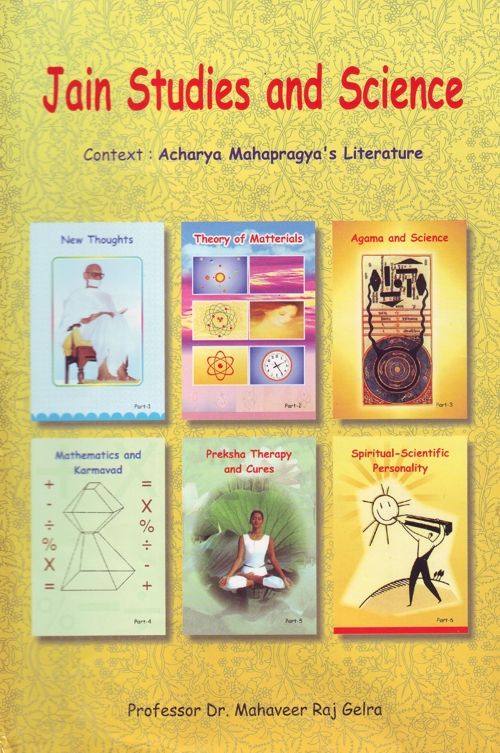Mahapragya has introduced a new chapter on Life Sciences in the field of education. According to him, the body, the mind and the soul work in consonance and need to be maintained in harmony, only then the orchestra of life will produce music. If these three components fall out of sync, we just listen to noise. We shall briefly analyze the concept of Life-sciences and its practical use in living the healthy and meaningful life. Man has evolved to its present state employing three natural tenets -
- hunger of knowledge (Jigyasa)
- Thirst of change (Bubhusha)
- Ability of action (Chikeersha)
Human being is full of quest. He is yearning to explore esoteric. He is also eager to break the monotony, tedium and tradition. He desires change and transformation. And to earn knowledge and to achieve change, he is raring to act. He is full of life-energy to do something.
Human being remains an animal until educated to become a part of civilized society. Education lays the foundation for progress.
Balanced Development
Growth on all fronts - physical, mental, behavioural and emotional - is the hallmark of life-sciences. Here we are not discussing the academic education, but the art of overall development of human personality. A balanced educational pattern only can result into the holistic development of a human being. Interestingly, the anatomy of human body has several aspects which are apparently beyond the conscious control, yet a student of life-science can learn an indirect method to address these autonomous functions to his advantage. In order to accrue these four-fold results, basic constituents of any comprehensive educational prototype should be -
- Sturdy Nervous System: Our consciousness is the result of an intricate nervous system. This system alone is responsible for our behaviour, thought and personality. Two streams of our autonomic nervous system - Ida and Pingla - medically known as sympathetic and parasympathetic, control most glands, heart, bronchi, arteries, stomach and intestine. Both sympathetic and para- sympathetic systems work in opposite manners. Stimulation of sympathetic nervous system increases heart rate which in turn results in aggression, antagonism and hostility, while the stimulation of parasympathetic system slows the heart beat and results in weakness, fear and inferiority. Only a balance of these streams of life can develop a proper personality.
- Biological balance: Second most important is endocrine system. This includes several glands like pituitary, hypothalamus, thyroid, adrenals, gonads etc. These glands secrete various chemicals called hormones. These hormones play a vital role in controlling wide range of body activities, such as digestion, excretion and reproduction. Any imbalance in the secretion of hormones may result in wide ranging ramifications. Equilibrium is essential for rational, intellectual and physical growth.
- Enhanced Mental Capability: It is now been medically established that humans use only 5-7% of the available mental resources. With 10% usage one can become a genius. This leaves for a tremendous scope for mental augmentation.
- Refined vision, conduct and sentiment: We know that the body organs (like various telephones) work through the nervous system (acting like telephone cable) and controlled by the hypothalamus (like telephone exchange). All these human hardware are coordinated and controlled by the software written in the brain cells. It is this software which can be refined, purified and decontaminated of bugs. While we have little control over the anatomical hardware available, we surely have control over the software formed by vision, conduct, emotions, sentiments and thoughts. The exercise of refining this software is essential part of Life-Science.
'A healthy body alone can house a healthy mind.' Life science believes in this axiom and extends this concept to spiritual awakening. According to Mahapragya, study of life-science has four fundamental elements -
1. Decontamination of Body- Relaxation through Kayotsarg
- Yoga-Asana
- Health Education
- Right inhalation
- Mitigation of Stress
- Resonance of Sound (Naad)
- Recitation of hymns and verses
- Determination and non-violence
- Value based teaching
- Preksha-Meditation
- Emotional health
While readers can find various Yoga techniques elsewhere, here it would be suffice to state that the various yoga-postures help in achieving balanced hormonal and chemical composition of the body. Mahapragya too has stressed the need of incorporating these time tested asana in one's daily life. He has given similar emphasis to various relaxation techniques which de-stress the mental tension. Relaxation through Kayotsarg has yielded proven results. Here, we shall elaborate on exercising 'Mahapran Reverberation.'
Mahapran ReverberationImportance: It addresses the body, caresses the mind and forms a prelude to embracing soul through meditation. It activates cerebral nerves, reduces restlessness and enhances concentration. Its regular practice results in slow and deep breathing, peaceful mind, strong memory and chaste behaviour.
Procedure:
- Bring body to standing posture of Sampadasana. Maintain body steady and relaxed.
- Slowly inhale through nose and retain the air in the lungs. Latch your attention to larynx.
- While keeping mouth shut, produce'm.......m' sound using vocal chords (larynx) and nose such that its reverberations are felt right up to the cerebral hemisphere.
- During this process let the lungs spontaneously exhale the accumulated alveolar air.
- Feel as if the entire body is engulfed in to the sound waves of Mahapran Reverberations.
- Now, inhale again. Repeating it five times is normally adequate.
This exercise can be attempted anywhere, anytime during the day. Benefits will be tangible within a short period of time.
Two-pronged StrategyThere are schools and institutions which impart education on wide ranging subjects but there is hardly any organized effort to impart moral and behavioural guidance. This lopsided stress on knowledge is slowly resulting in weird sadism, bizarre violence, and barbaric treatment of weaker strata of society, which includes not only economically poor but women and children too. This calls for an immediate strengthening of our moral back-up programs. Study of Life-sciences as proposed by Mahapragya is a timely step in right direction as it emphasizes on four-fold development -
- Management of Emotions, Values and Virtues
- Mitigation of Temper and Destructive Tendencies
- Enrichment of Positive and Constructive Energy
- Nurturing of Team and Social spirit
We must acknowledge the fact that all humans born with natural instincts which have both virtues and vices. These emotions of anger-compassion, revenge-forgiveness, love-hate, etc. are nothing but various chemical activities within the brain. And these activities can be controlled through the proper software programming of thoughts. To achieve this we shall have to adopt two-pronged strategy - one of acquiring academic excellence through institutional education and second of practicing life-sciences through meditation, yoga and moral building. Mahapragya says the vehicle of life can run and achieve new goals if the two wheels of knowledge and character are maintained well balanced. And then only the moral bankruptcy, blatantly visible today, will give way to cultural and spiritual richness.
 Dr. Mahavir Raj Gelra
Dr. Mahavir Raj Gelra

